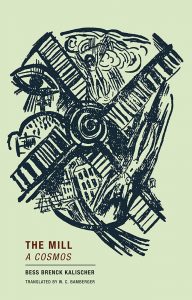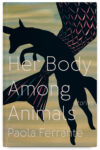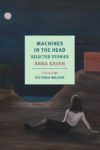
[Wakefield Press; 2021]
Tr. from the German by W.C. Bamberger
At the turn of the 20th century, weird communities flourished in modernizing German cities, fostering pockets of literary experimentation. This movement signaled a turn away from the Victorian era of class and provincialism, which was capped off by Buddenbrooks, Thomas Mann’s domestic drama about a wealthy family’s generational splintering. What rose in the wake was an existentialist and post-Kant-inspired freedom of expression, developing around everything from occultism to architecture, from perpetual motion machines to science fiction. It was in this atmosphere that Bess Brenck Kalischer began making a name for herself in Dresden and Berlin. She was an arbiter of taste. In 1923, the same year Kalischer founded the Association of Proletarian Writers, a notoriously savage gossip writer named Emil Szittya wrote in Das Kuriositaten-Kabinett: “She has strangely staring eyes, is ugly and fat. Short gray hair. Writes poems and novels and is known for the fact that all of Berlin’s writers have already sought her love.”
An expressionist prose-poem with little in the way of concrete plot, or even setting, or character, The Mill is a smirking sphinx, packed with wisdom that remains partly obscured by a Magic Eye puzzle of symbolism, fairy tale references, and outer space. The only structure comes from spare mentions of everyday activities, such as moving rooms and receiving medications, in a mental hospital that happens to be occupied by 70 percent women. This is a common setting across German literature. Its accompanying detail stands out not only for being specific, but also for reinforcing a pointed question posed to the reader earlier in the novel: “Ask yourself, what sensitive woman can endure life as it is today without becoming mentally ill?” (The answer? Not this one). This one example from the text delivers a classic German backdrop offset by a crystallization of Bess’s forceful perspective. She achieves this feat throughout The Mill; among the abstract imagery and classical motifs, she drops one-liners that lend a sense of epiphany and delight.
With these breaths of lucidity, Kalischer kept me engaged, interested in connecting as many dots as possible. On many pages, my eyes went in and out of focus, not from boredom or distraction, but instead wondering whether if I stared at it for long enough, or just the right way, Bess’s vision would emerge. For example, after a violent opening salvo (“It strained, thrashed, screamed. Rose. Crust shattered.”), she comes around and delivers what seems to be a thoughtful wink: “It was long, long ago, said the diamond to the coal. Didn’t I tell you that it all depends on the light? replied the coal as it burned.” And there are times when she is earnest and hopeful despite the bleak setting: “The inclination toward the other, beyond us, resonates in every living being.” These crystallizations of thought are buoys in Bess’s sea of psyche. And even she seems to acknowledge the position she’s putting her readers in, as she delivers another memorable moment, “I once knew the author of this story. It will certainly generate a pyramid of misunderstandings among literary historians.”
Despite these obscurities, Bess also takes on well-trod German terrain — at least, it would become well-trodden. There is the aforementioned sanitarium, where the narrator’s stifled worldview as a woman trapped by society’s expectations is fortified: “He has made the room with the view available for me. The most beautiful room. But here, too, the windows are barred. Didn’t I once write: And no logic helps me, as far as the bars being imaginary. Here the bars are real, and I am free.” This use of the mental hospital as a framing device and disorienting setting precedes Thomas Mann’s The Magic Mountain by a few years, as well that of The Tin Drum by Gunter Grass, among other examples. There are also references to Eastern themes, symbols, and religions, which feature prominently in German literature from the first half of the 20th century, including The Transposed Heads by Thomas Mann, Siddhartha by Hermann Hesse, and Three Leaps of Wang Lun by Alfred Döblin. Lastly, she playfully torches Kant’s role in the Enlightenment: “Kant would be inconceivable without me, said the mirror.” In these ways, Kalischer is thoroughly German.
But the author also conveys what feels like an intimate snapshot of her psyche. She references her friend and fellow writer “S. Friedlaender,” who used the pen name Mynona and wrote Kafkaesque-before-Kafka stories that offer a domestic backdrop for tales of witchcraft and sadism. Friedlaender also wrote a review of The Mill upon its release, in which he described it as “a masterpiece” among the “higher poetic genres.” Kalischer shows a personal interest in mythology, the cosmos, and as you might expect given the title, Don Quixote. Bursting rockets serve as a bleak militaristic timekeeper throughout a good portion of the work. It’s free-flowing and unpredictable. Some sections are pages long and include both prose and poetic formatting at times. Some are just three sentences long, like “The Snails”: “The snails established a union to battle individualism. Every snail should bury their own thoughts in their own home. As I have always said, you have to start with yourself.” Ultimately, the novel is thoroughly expressionistic and serves to embody Bess as a person and an artist. This is achieved with impeccable control and variety, not just in terms of breadth and length, but also potency.
The impressionistic structure requires readers to meet The Mill on its own terms, and when these impressions are layered over with style, the enchanting, the funny, the interest in others’ cultures — it all speaks to a personality that is genuinely and fearlessly curious about themselves, others, and the world in general. It’s no wonder all of her peers respected her so much.
Justin Stephani is an editor and writer living in Milwaukee.
This post may contain affiliate links.







